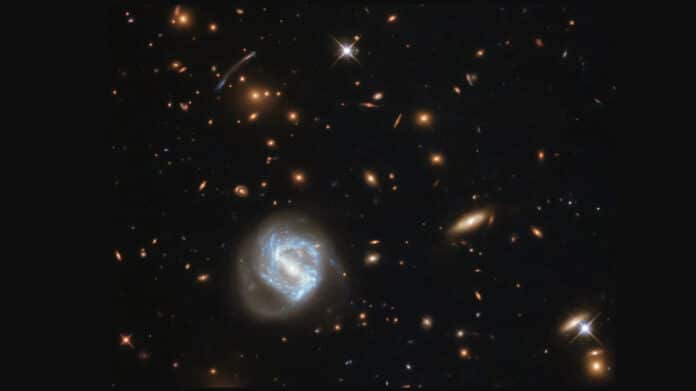Knowing where and how much stuff there is will help you better understand the cosmos. The largest objects in the universe are galaxy clusters, which can contain hundreds to thousands of galaxies as well as plasma, hot gas, and dark matter. These elements are bound together by the gravity of the cluster. It is essential to comprehend such galaxy clusters to determine the beginning and ongoing evolution of the cosmos.
The total mass of a galaxy cluster is arguably the most important factor in defining its characteristics. Yet, estimating this amount is challenging because galaxies cannot be “weighed” by putting them on a scale. The fact that dark matter, which accounts for a sizable portion of a cluster’s mass, is unseen adds to the difficulty. Instead, they infer a cluster’s mass from other measurable characteristics.
Astrophysicists at the Institute for Advanced Study, the Flatiron Institute, and its associates have developed a more accurate method to determine the mass of gigantic galactic clusters using artificial intelligence. The AI discovered that scientists might get much better mass estimates than they had by adding a simple term to an existing equation.
Study co-author Francisco Villaescusa-Navarro, a research scientist at the Flatiron Institute’s Center for Computational Astrophysics (CCA) in New York City said, “It’s such a simple thing; that’s the beauty of this. Even though it’s so simple, nobody before found this term. People have been working on this for decades, and still, they could not find this.”
This new AI, called ‘symbolic regression,’ essentially tries out different combinations of mathematical operators — such as addition and subtraction — with various variables to see what equation best matches the data.
Scientists “fed” their AI algorithm a cutting-edge simulation of the universe that included several galaxy clusters. Then, Miles Cranmer, a CCA research fellow, used their program to look for and identify any additional variables that might improve the mass estimates.
Digvijay Wadekar of the Institute for Advanced Study in Princeton, New Jersey, said, “Right now, a lot of the machine-learning community focuses on deep neural networks. These are very powerful, but the drawback is that they are almost like black boxes. We cannot understand what goes on in them.”
“In physics, if something is giving good results, we want to know why it is doing so. Symbolic regression is beneficial because it searches a given dataset and generates simple mathematical expressions in the form of simple equations that you can understand. It provides an easily interpretable model.”
By adding a single new term to the current equation, the researchers’ symbolic regression program provided them with a new equation that was able to more accurately forecast the mass of the galaxy cluster. Wadekar and his associates then discovered a physical explanation by working backward from this AI-generated equation. They discovered that the presence of supermassive black holes at the centers of galaxies and other regions of galaxy clusters where mass inferences are less accurate are correlated.
Their new equation reduced the significance of the intricate cores in the calculations, which enhanced mass estimations. The galaxy cluster resembles a doughnut in shape. The new equation eliminates the jelly in the doughnut’s center, which can cause bigger inaccuracies, and instead focuses on the doughy edges for more accurate mass inferences.
Using tens of thousands of simulated universes from the CCA’s CAMELS suite, the researchers tested the equation that was discovered by AI. In comparison to the currently employed equation, they found that the equation reduced the variability in galaxy cluster mass estimations by about 20 to 30 percent for big clusters.
Wadekar noted, “The new equation can provide observational astronomers engaged in upcoming galaxy cluster surveys with better insights into the mass of the objects they observe. There are quite a few surveys targeting galaxy clusters [that] are planned in the near future.”
“Examples include the Simons Observatory, the Stage 4 CMB experiment, and an X-ray survey called eROSITA. The new equations can help us maximize the scientific return from these surveys.”
Journal Reference:
- Digvijay Wadekar et al. Augmenting astrophysical scaling relations with machine learning: Application to reducing the Sunyaev–Zeldovich flux–mass scatter. Proceedings of the National Academy of Sciences. DOI: 10.1073/pnas.2202074120
